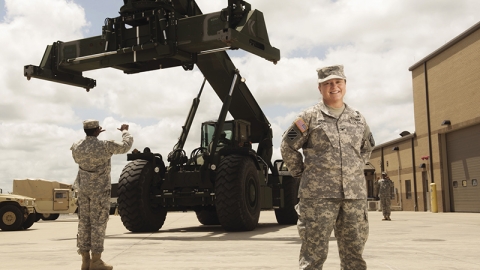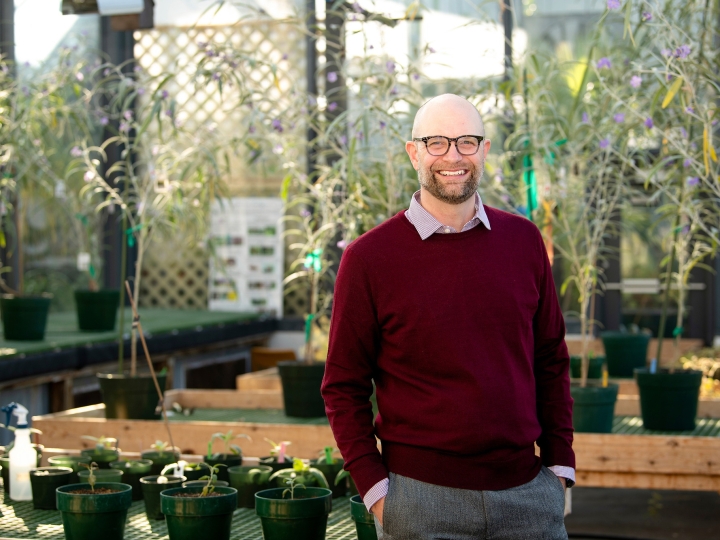
The Lifeliners
July 17, 2015
Col. Kimberly Parsons Daub '89
Combatting Ebola in a place like Liberia takes more than experienced personnel. It takes an entire infrastructure — built from scratch — and Col. Kimberly Parsons Daub '89 and her troops were the ones to create it.
Here’s how the Ebola crisis in West Africa began: According to the journal Science, sometime toward the end of 2013 a single case erupted in Guinea, likely after the first victim was bitten by an infected bat. A fever might have been the first clue that something wasn’t right. Then came the headaches and muscle pain and fatigue. It might have felt a little like the flu in those early stages. Or malaria. But this was something different. When the Ebola virus makes its way through a body, it assists that body in slowly destroying itself from the inside out as it attacks organs and causes internal bleeding. In someone with a poor immune system and little to no medical attention, Ebola kills painfully and slowly over days as organs shut down and the body bleeds out. Even with good medical care, the chance of survival is a mere 50 percent.
That single bat bite would go on to spawn nearly 27,000 human cases in West Africa — the largest Ebola outbreak since the disease debuted in 1976. As people got sick or died, caretakers handled their bodies without protection, exposing themselves to blood and fluids, and giving Ebola new hosts to destroy. The World Health Organization estimates that more than 11,000 people have perished since the current outbreak’s start.
It could have been even worse. In the beginning, West African countries were ill-equipped to handle the rapidly spreading virus without proper medical facilities and education about the ways in which the disease spreads. The governments in Liberia, Guinea and Sierra Leone asked for help, and the international community stepped in.
By September 2014, Col. Kimberly Parsons Daub ’89, the Army’s first female commander to lead a brigade at Fort Campbell in Kentucky, had orders from President Barack Obama to gather her 750 troops, all part of the 101st Sustainment Brigade, 101st Airborne Division, and get ready for battle.
No one would likely be shooting at Daub and her troops — not as they did during her years of deployments in Iraq and Afghanistan — but this enemy was just as deadly, and one they had never encountered before.
Combatting Ebola in a place like Liberia takes much more than bringing in doctors. It requires building something that didn’t exist before — an entire system of Ebola treatment units (ETUs), testing labs and the facilities to house the soldiers — and health-care workers trained to keep that system going. It means the creation of a base camp to receive and distribute international aid from the U.S. and other countries. It even requires improvements to existing airport runways in order to accommodate the weight and size of military aircraft bringing the supplies, the people and the tent cities to house it all.
Building that infrastructure was Daub’s mission, one for which she had little time to prepare. In previous deployments, Daub and her troops typically had six months to get ready. But Ebola wasn’t waiting, so they prepared to head to West Africa within a matter of weeks. "We were building the plane as we were flying it," Daub says with a laugh.
In those weeks leading up to their departure, she and her team had to get up to speed quickly on West African culture and make contacts in Liberia, where they would stay for five months. The brigade, also known as The Lifeliners, would need to learn quickly how to don and remove Tyvek suits in order to protect themselves and their families upon their return. "It was my responsibility from the first day of planning," says Daub, "to change the mindset of our force and prepare them to operate under a new set of rules in very uncertain conditions." But that wasn’t the hardest part. "Among the most difficult aspects prior to and during this deployment has been explaining to family members — many of whom have been separated from their soldier spouses for multiple year-long deployments — that there was a real need for U.S. assistance in Liberia," she says. Daub had to calm the fears of wives and husbands and parents who were watching the media storm play out in the U.S. as newscasters and media personalities interviewed doctors and tracked the progress of ill healthcare workers. At one point, helicopter news crews followed the transport of ill nurse Nina Pham from Texas to the National Institutes of Health. Anyone watching television that evening could see Pham boarding a plane in a Tyvek suit, and later viewers watched as the ambulance that carried her made its way to the NIH. The possibilities of infection just seemed too close to home.
Daub, who attended Bucknell on a ROTC scholarship, talked about the risks involved and the precautions the military would take with the soldiers — men and women, some just 18 and 19 years old — that she lovingly refers to as her kids. "Their ingenuity is amazing," she says. "Give us a task and a purpose, and we’ll get it done."
Their task once in Liberia was to provide logistic support to efforts led by the U.S. Agency for International Development, and the work began upon landing at Roberts International Airport in Liberia in October. The initial arrivals, Joint Task Force – Port Opening, repaired potholes so planes could safely land with precious and much-needed cargo. Daub’s team then headed to two different military bases outside of Monrovia, where they established base camps complete with mess halls to fit 450 people at one location and 750 people at the other, a tent city to house soldiers and a warehouse from which personnel would welcome, organize and distribute equipment coming in from 15 countries, including the U.S.
The Joint Task Force Army engineers then spread out into the local communities to drill wells at potential ETU sites and to build the units themselves from tents. One tent was for donning protective suits, one for removing them — both with only one way in and one way out to prevent contamination. There were tents for supplies, tents for suspected cases, more tents for those confirmed. The Army health-care workers from the 86th Combat Support Hospital worked to train the medical personnel and others who would be handling patients and bodies on how to use protective gear and keep the disease at bay. The health-care workers then developed onsite labs for blood tests, which formerly had to be shipped to Guinea. The new labs cut diagnosis time down from weeks to hours. The Lifeliners next created a financial management system so the personnel could transfer money into the country. "It’s not like there are a lot of ATMs around for troops to grab cash," says Daub.
But on any mission, one of the toughest and most important aspects is adapting to the culture and earning the respect of the people with whom you’ll be working. For Daub, who served in Operation Enduring Freedom in Afghanistan and earlier as a platoon leader in Operations Desert Shield and Desert Storm, that meant reaching out to leaders in areas such as the town of Buchanan, Liberia. "We had the privilege to work with the superintendent— the equivalent of a governor in America — of Grand Bassa County, Ms. Etweda Cooper. We worked closely with her on land use agreements and cooperation between our soldiers and local government agencies," says Daub. "Ms. Cooper was well prepared to help her citizens recover from this type of crisis. Previously, she worked tirelessly to end the bloody civil war in Liberia, the scars of which are still visible a decade later."
That cooperation was a force. Within weeks, Ebola was slowly relenting amid the infrastructure built to combat it.
It’s March 2015, and Daub is sitting in her temporary office at Fort Bliss, Texas. She and several hundred soldiers arrived a few days ago after washing down all of their equipment and ships in Liberia in order to meet U.S. agriculture standards, and then loading those ships with Humvees and the tents they lived in while away from their families and children, a few of whom were born in their absence.
She and her troops are cordoned off from the rest of the military men, women and families housed here with bright orange plastic barriers, typically used to keep snow from drifting onto highways and roads. She will be here, barricaded with her troops for 21 days to make sure no one shows any symptoms of the enemy they had spent months fighting.
But even in quarantine, life isn’t so bad. There are workout facilities, offices, relatively comfortable beds, even video games to pass the time. (Daub admits she’s spending a good deal of time on Pinterest.) And if a soldier does spike that dreaded fever, he or she will be quickly cared for with all of the quality and comforts of the American medical system. But chances of that happening, says Daub, are incredibly small. Not with all the precautions they took. Not with the training they had and passed on to the people of Liberia. In fact, in 21 days, the soldiers will all be released without a single case.
But Daub isn’t there yet. For now, she’s sitting at Fort Bliss, and she’s ready to be home with her husband and two sons, who at 13 and 16 are used to the fact that mom heads out every once in a while with her other kids to keep people safe in one way or another. For Daub, this mission was an incredible success. Just one day before she sat down in this office to work, media reported that the last known Ebola patient in Liberia had been discharged, though a few cases remain in other areas of West Africa. "Now as we prepare to go home," says Daub, "I can confidently tell each and every family that their soldiers will return safely and that their military has made a difference."
